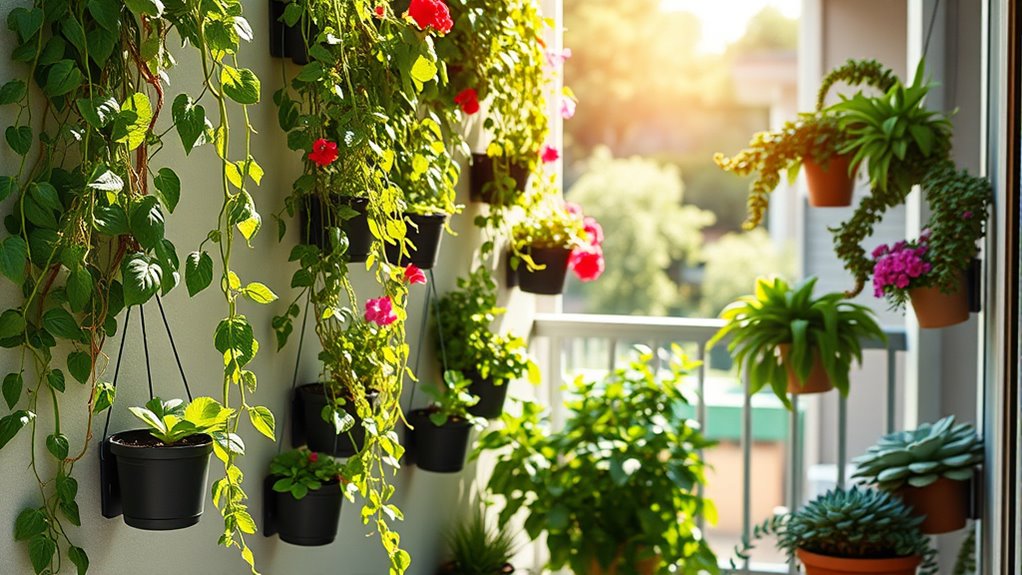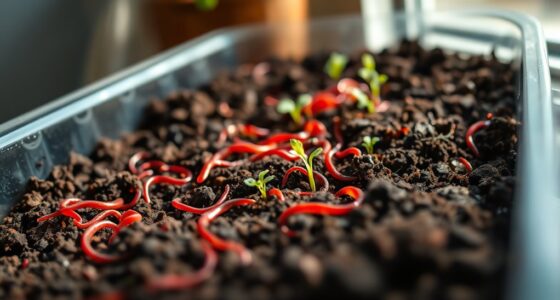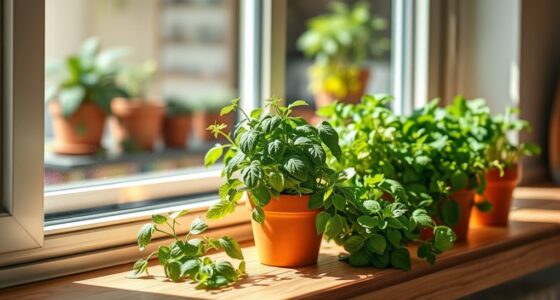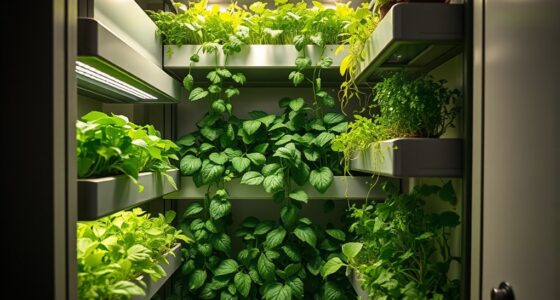Vertical gardening lets you maximize small spaces by growing plants upward on walls, trellises, or hanging containers, saving ground area and increasing production. Choose sun-appropriate plants and group those with similar needs for easier care. Use sturdy structures and containers with drainage. Regular watering, fertilizing, and pruning help keep your garden healthy. Carefully plan your layout for flow and access. Keep exploring to discover creative tips and tricks to make your vertical garden thrive.
Key Takeaways
- Map your available space and sunlight to choose suitable plants and optimal placement.
- Select support structures like vertical planters or hanging containers for efficient use of small areas.
- Pick plants matching light conditions and water needs to simplify maintenance and ensure healthy growth.
- Incorporate creative containers and decorative elements to maximize aesthetic appeal in limited space.
- Regularly monitor moisture, support, and pests to keep your vertical garden healthy and productive.
Understanding the Benefits of Vertical Gardening
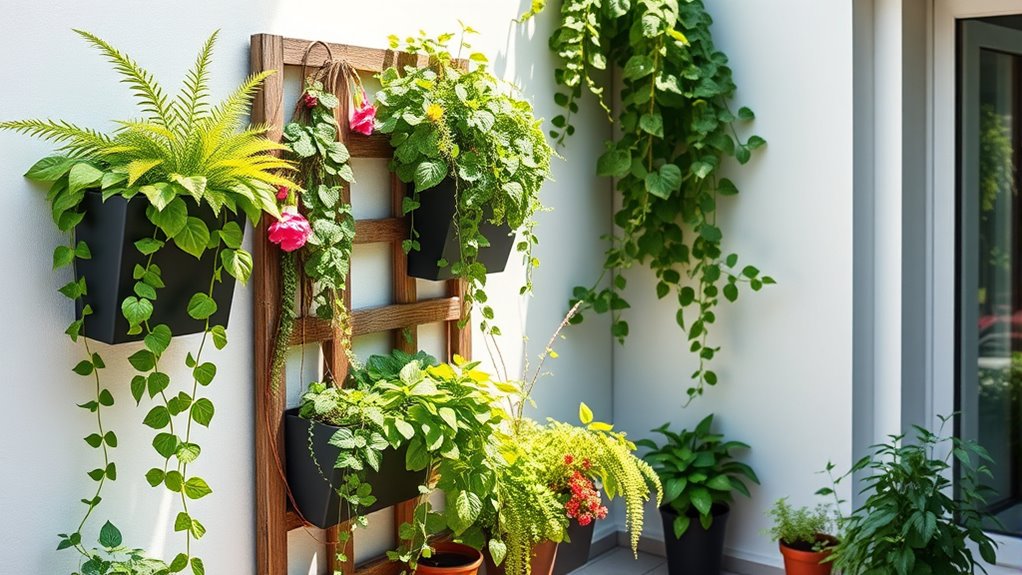
Vertical gardening offers numerous advantages, especially if you’re limited on space. With vertical gardening, you can maximize your small space by growing more plants vertically on walls, trellises, or hanging systems. This approach effectively increases your garden’s capacity without needing extra ground area. Growing vertically also improves air circulation around your plants, helping to prevent common diseases like blight and powdery mildew. By elevating your plants, you reduce ground contact, making weed competition and pest management easier. Additionally, vertical gardens often require less effort for maintenance and harvesting, making gardening more accessible. Studies show that vertical gardens can yield higher productivity per square foot compared to traditional gardens. Incorporating innovative design into your vertical garden can further enhance its aesthetic appeal and efficiency, especially when considering space-saving techniques that optimize limited areas. Choosing the right planters is essential for ensuring your plants receive proper support and hydration, ultimately contributing to a thriving vertical garden. Proper watering methods are also crucial to prevent over- or under-watering, which can affect plant health. Maintaining proper plant health is essential to ensure your vertical garden thrives over time.
Choosing the Right Plants for Your Vertical Space
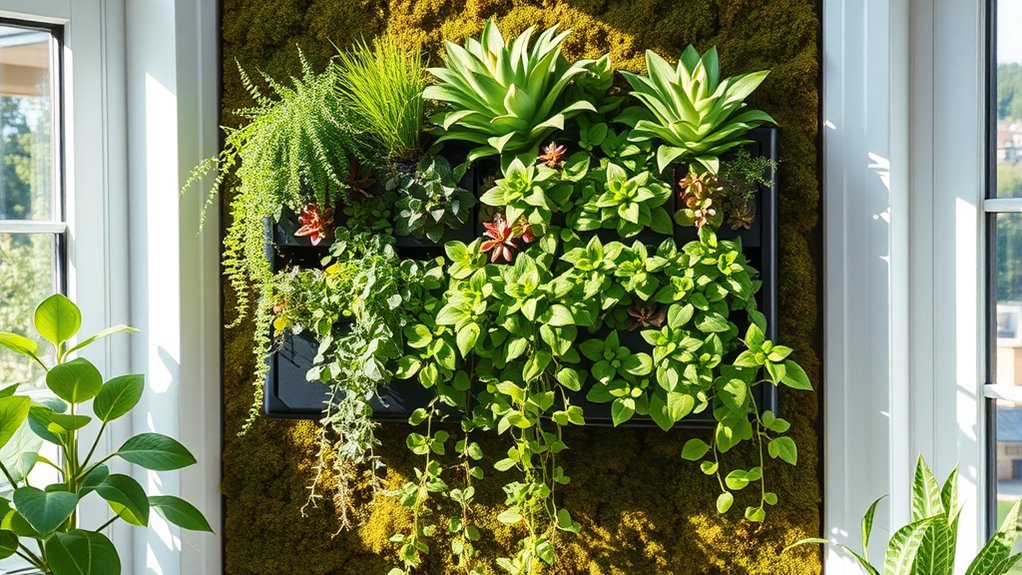
To choose the right plants for your vertical garden, consider your light conditions and available space. Some plants, like lettuce and herbs, thrive in shade, while others, such as peppers and beans, need full sun. Picking plants with similar water and nutrient needs makes caring for your garden easier and more efficient. Additionally, understanding the trustworthiness of AI models can help you make better decisions about which plants to select and care for. Being aware of the affiliate disclosure ensures transparency when researching gardening supplies and tools. Incorporating automation in business principles can also help streamline your gardening routines and maintenance tasks. Furthermore, selecting plants that promote emotional well-being can enhance your overall gardening experience and create a more relaxing environment. Recognizing the personality traits of your chosen plants, such as their growth habits, can assist in creating a harmonious and thriving vertical garden.
Light Requirements
Ever wonder how to choose the right plants for your vertical garden based on light? Understanding light requirements is key to success.
Most plants in vertical gardens need at least 4-6 hours of direct sunlight daily, but leafy greens and herbs can do well in partial shade with just 2-4 hours of light. Additionally, knowing how to measure sunlight exposure can help you optimize plant placement for healthier growth.
Tomatoes, peppers, and climbing beans thrive in full sun, needing 6 or more hours of direct light for healthy growth and fruit.
If you’re working with a north-facing wall or shaded area, opt for shade-tolerant crops like lettuce, spinach, or herbs like mint and parsley.
Use a light meter or observe sunlight patterns to find a sunny spot in your growing space, ensuring your plants receive the right amount of light for *ideal* growth.
Additionally, understanding the signs of spoilage in lemon juice can help you select fresh ingredients for your garden or kitchen, ensuring maximum flavor and safety.
Space and Size
Wondering how to choose plants that fit your vertical garden’s space? Start by matching plants to your vertical space’s size. For small gardening space, select compact plants like herbs or small vegetables. Use plant support structures like trellises for vining crops to maximize your space. Consider plant growth habits: trailing strawberries or climbing beans naturally grow upward, saving room. Pay attention to the mature height and spread to prevent overcrowding, ensuring proper light and airflow. Additionally, understanding plant spacing can help you plan your garden layout effectively, especially when considering the natural materials used in farmhouse-style decor which influence the overall aesthetic. Proper water management is also crucial to keep your plants healthy in a vertical setup. Keep in mind that choosing the right plant technology can further enhance growth and maintenance. Being aware of survival gear essentials can also be beneficial in case of emergencies that might disrupt your gardening routine. Here’s a quick guide:
| Plant Type | Support Structure | Ideal Space |
|---|---|---|
| Herbs (basil, mint) | Small containers | Narrow walls |
| Tomatoes | Trellis | Tiered towers |
| Climbing beans | Trellises | Vertical fences |
| Trailing strawberries | Hanging baskets | Small balcony edges |
Matching plants with your space helps you maximize your space and enjoy healthy plant growth habits.
Selecting Suitable Structures and Containers
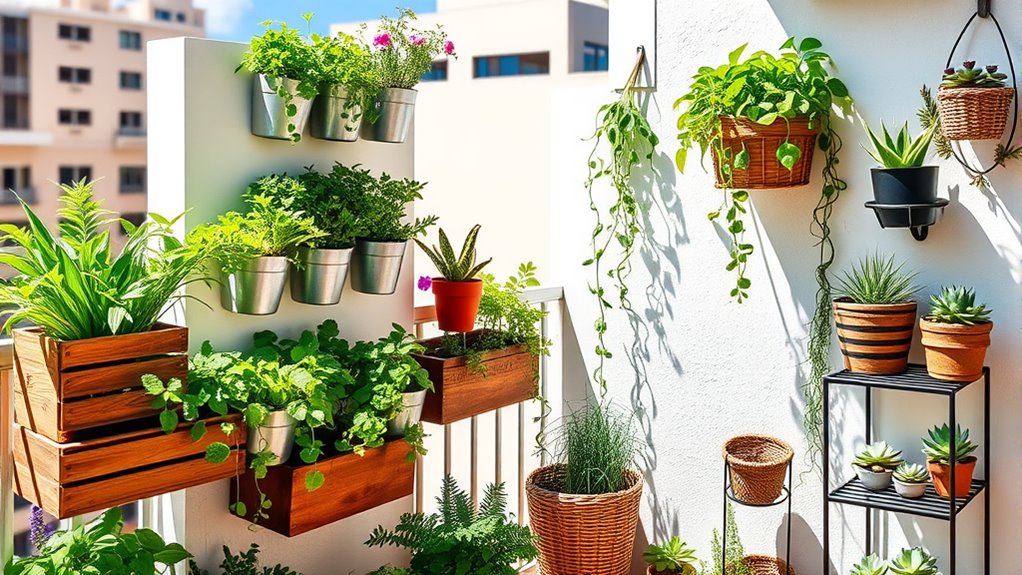
Choosing the right structures and containers is essential for a successful vertical garden. To optimize small spaces, select versatile options like vertical planters, stacking towers, and hanging containers. These structures maximize vertical growth and save ground area. Additionally, ensure that your chosen containers meet lease requirements, such as having proper drainage and durable materials, to promote healthy plant development. When choosing containers, ensure they’ve drainage holes to prevent waterlogging and support healthy root development. Consider durable materials that withstand weather and frequent handling.
For plant variety, use wall-mounted planters for herbs and flowers, stacking towers for vegetables, and hanging containers for trailing plants. Each option allows easy customization and rearrangement, making them ideal for small patios or balconies.
Picking suitable structures tailored to your plants and space helps create a thriving, manageable vertical garden.
Planning Your Vertical Garden Layout
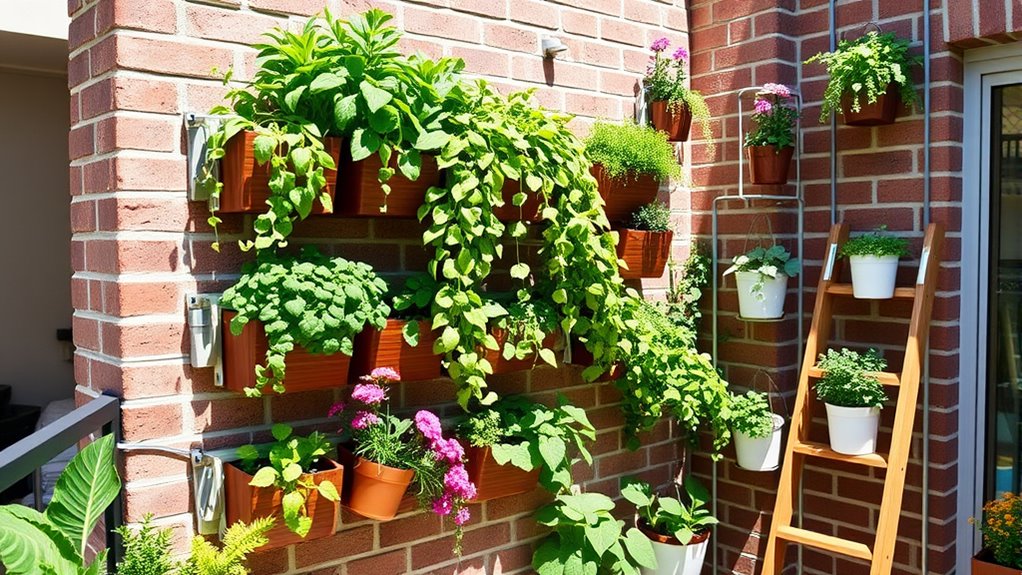
To create an effective vertical garden, start by mapping out your available space and evaluating sunlight exposure, as both factors influence your choice of structures and plant placement. Incorporate nutrient retention strategies by selecting materials and techniques that preserve soil health and plant vitality. Measure the dimensions carefully to select support structures that fit comfortably within your area. Consider how much sunlight different spots receive to determine the best locations for sun-loving versus shade-tolerant plants. Plan your plant arrangement by grouping taller or climbing plants where they won’t overshadow shorter ones, maximizing space and growth potential. Incorporating various support structures like wall-mounted containers, trellises, or stackable planters can help maximize space and improve airflow, reducing disease risks. Additionally, choosing appropriate soil mix can improve plant health and reduce maintenance needs. Using vertical storage solutions can further help in organizing tools and supplies, keeping your gardening area tidy and functional. Remember that selecting sustainable gardening practices can promote environmental health and ensure your garden thrives over time.
Building and Installing Support Systems

Building a sturdy support system is key to a successful vertical garden. Proper support structures keep climbing plants stable, prevent damage, and promote healthy growth. Here are essential steps:
- Choose suitable trellises, cages, or arbors made from wood, metal, or plastic, ensuring they’re strong enough for mature plants.
- Anchor your planting structures securely into the ground or attach them to walls, considering wind resistance and weight.
- Use adjustable supports like A-frame or ladder trellises for easy access, pruning, and harvesting.
- Reinforce support systems with stakes or T-posts to handle heavier plants like tomatoes or cucumbers, maintaining plant stability and airflow.
Effective anchoring and support installation optimize airflow and plant health in small vertical spaces.
Proper Watering and Fertilizing Techniques
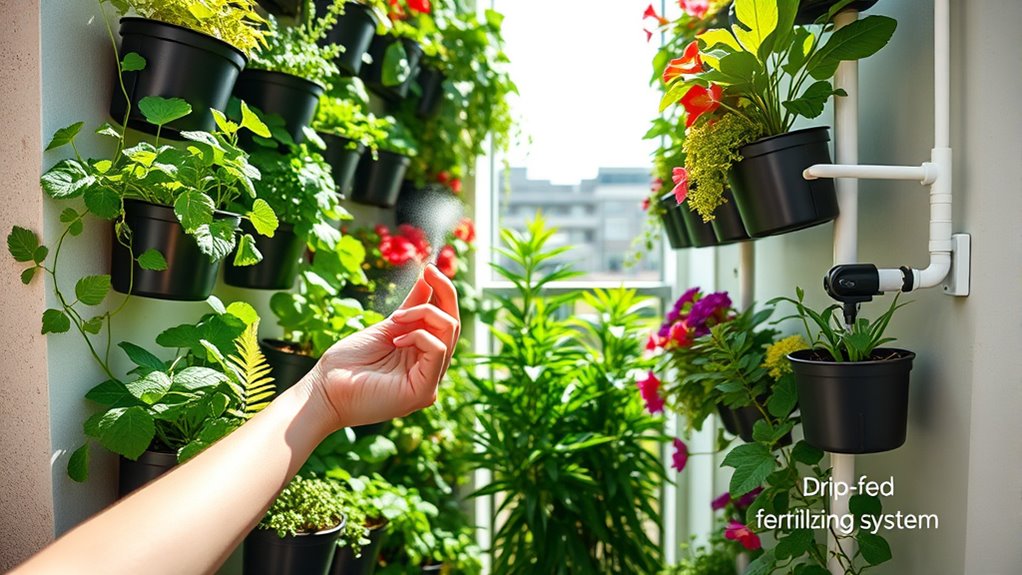
Vertical gardens tend to dry out faster than traditional ground plots, so you’ll need to water more frequently—often daily or twice daily in hot weather. Use watering tools like wands or soaker hoses for gentle, even moisture directly at the roots, reducing water waste. Regular fertilizing with slow-release or liquid nutrients ensures a steady nutrient supply. To prevent waterlogging, elevate containers on pot feet, stands, or casters for better drainage. Check soil moisture by inserting your finger or lifting containers to assess water levels and adjust watering accordingly. Effective water management keeps plants healthy and thriving.
| Watering Techniques | Fertilizing Strategies |
|---|---|
| Use soaker hoses or wands | Apply slow-release or liquid fertilizers regularly |
| Monitor soil moisture | Tailor nutrient supply to plant needs |
| Elevate containers for drainage | Ensure consistent fertilizing for growth |
Maintaining and Troubleshooting Your Vertical Garden
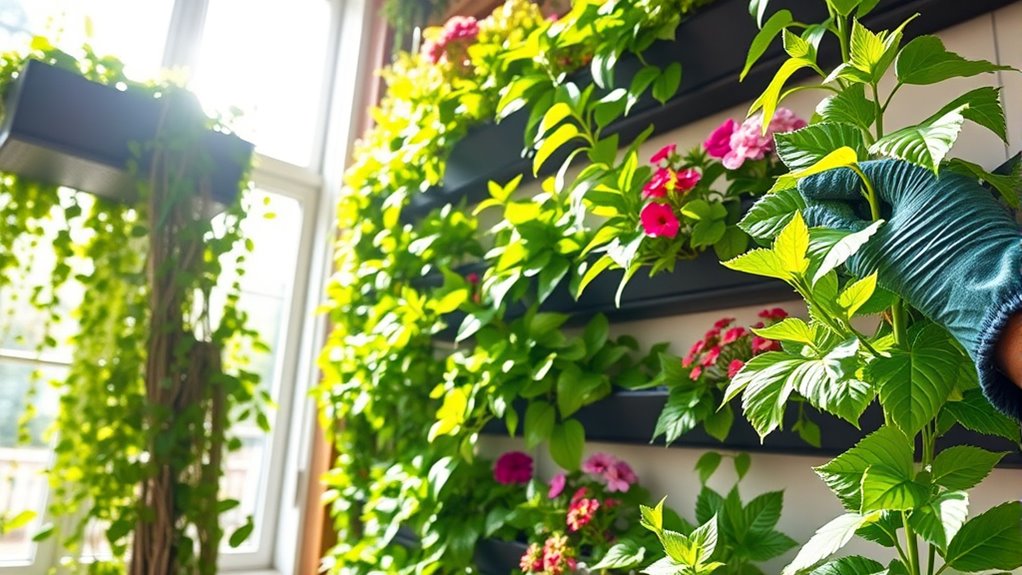
Regular inspection is key to keeping your vertical garden healthy. You should check for pests or diseases regularly, as they spread quickly in confined spaces. Address issues immediately to avoid plant loss.
To maintain your garden’s vitality, focus on these essentials:
- Guarantee proper watering and drainage by checking soil moisture daily; dry-out or waterlogging can harm plants.
- Support taller or heavy plants with stakes, cages, or trellises to prevent damage, especially during wind.
- Prune regularly to promote airflow, reduce overcrowding, and prevent fungal problems.
- Keep an eye on plant support structures and adjust them as needed to sustain growth and stability.
Tips for Maximizing Productivity and Aesthetic Appeal
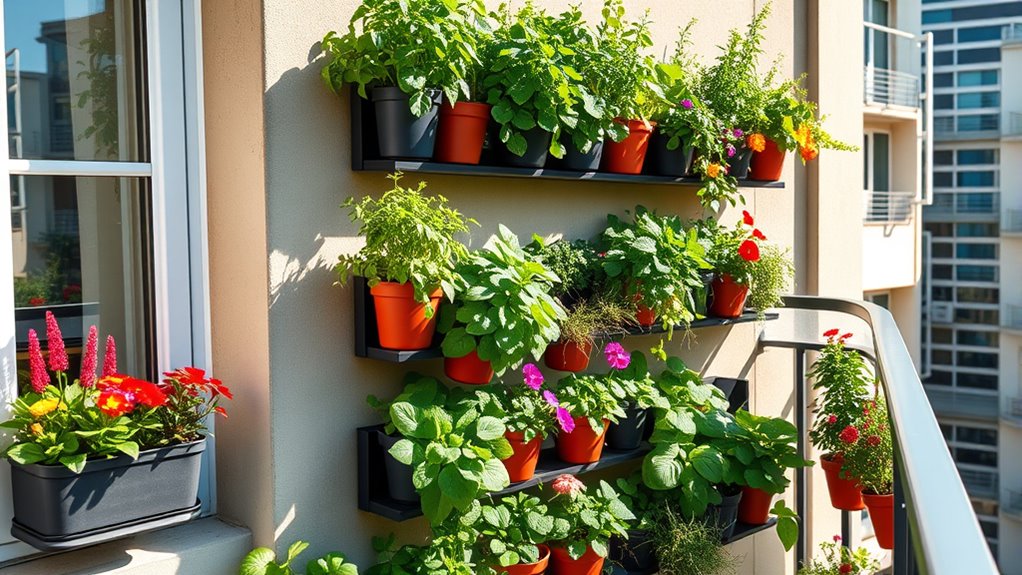
To maximize both productivity and aesthetic appeal in your vertical garden, focus on thoughtful plant selection and strategic arrangement. Use a mix of colorful flowers and lush foliage to create visual interest while hiding structural supports, enhancing the overall look of your small garden.
Optimize your vertical garden with vibrant plants and strategic layout for beauty and productivity.
Incorporate hanging plants and decorative containers in various sizes and styles to add personality and complement your space. Arrange plants with different heights and textures for a layered design that creates depth and visual impact.
Guarantee proper plant support to keep everything secure and healthy. Regular pruning and maintenance keep your garden tidy and vibrant throughout the growing season.
Balancing edible and ornamental plants not only boosts productivity but also creates a harmonious, eye-catching display.
Creative Ideas to Enhance Small-Space Vertical Gardens

To make your vertical garden stand out, consider using recycled materials like plastic bottles, pallets, or old rain boots as planters. Incorporating support structures such as trellises or A-frame supports can give climbing plants more room to grow.
Adding layered systems or attaching small pots to walls can also boost your garden’s capacity and visual appeal.
Unique Container Options
Transforming everyday items into unique containers can turn your small vertical garden into a lively, personalized space. Recycled containers like rain boots, mason jars, and plastic bottles serve as creative garden containers that add charm and function.
Vertical planters made from pallets enable you to grow herbs or small vegetables in a customizable, eco-friendly way, perfect for urban gardening. Consider using unique pots such as vintage teacups or metal tins to boost visual appeal and maximize limited space.
To inspire your creativity, explore these options:
- Recycled containers—think colorful cans or old shoes
- Pallet gardens—DIY wooden structures for versatile planting
- Vintage or decorative pots—add personality and style
- Creative garden containers—repurposed items that marry form and function
These ideas help you craft a distinctive, space-efficient vertical garden.
Innovative Support Structures
Creative support structures can markedly boost the functionality and visual appeal of your small vertical garden. Support structures like trellises, teepees, and modular systems help maximize vertical space while providing sturdy frameworks for climbing plants such as beans, cucumbers, and squash.
You can craft affordable, customizable options using recycled materials like scrap wood, old ladders, pallets, or garden arches, adding charm and sustainability.
Installing tension wires, twine, or cable systems between walls or posts offers flexible, adjustable support for vining crops.
Decorative elements like hanging pots or wall-mounted grids serve dual purposes—support and aesthetic enhancement.
These innovative solutions not only optimize space but also make your garden more dynamic and engaging, turning small areas into thriving green retreats.
Frequently Asked Questions
Are There Any Drawbacks to Using Vertical Gardens?
You might find that vertical gardens have some drawbacks. They can retain too much water, risking root rot if drainage isn’t good enough.
You’ll need to water more often because they dry out faster. Structural support can be costly and may need reinforcement, especially in windy areas.
Plus, limited soil space can restrict plant growth and yield, and some plants may struggle with light or root space.
What Plants Are Good for Small Vertical Gardens?
Imagine your small space blooming like a vibrant tapestry. You can grow herbs like basil, parsley, and cilantro, which love compact spaces.
Or climbing vegetables like pole beans and cherry tomatoes that naturally reach upward. Leafy greens such as lettuce and spinach fill vertical containers quickly.
Strawberries can hang in baskets. Even small root vegetables like radishes thrive in shallow vertical setups, turning your tiny garden into a lush, edible paradise.
How to Make a Simple Vertical Garden?
To make a simple vertical garden, start with a sturdy wall, fence, or frame. Attach small containers or pockets using screws, hooks, or zip ties, and use repurposed items like pallets or shoe organizers. Make certain each has drainage holes.
Arrange containers in tiers for sunlight and airflow.
Water regularly, focusing on the top tiers first, and consider drip irrigation or long-spouted watering cans for efficiency.
How to Garden in a Small Space?
To garden in a small space, focus on maximizing vertical areas like walls and fences. Choose compact plants such as herbs, dwarf tomatoes, or climbing beans that thrive in containers.
Use structures like trellises, wall-mounted planters, or stackable systems to create multi-layered gardens.
Regularly water, space your plants properly, and manage nutrients to keep them healthy.
Get creative with repurposed containers for an attractive, productive garden that fits your limited space.
Conclusion
With vertical gardening, your small space transforms into a lush oasis that rivals a jungle! By choosing the right plants, structures, and maintenance techniques, you can create a stunning, productive garden anywhere. Remember, your creativity is the only limit—so don’t hold back. Start small, stay consistent, and watch your vertical garden flourish into a breathtaking paradise that’ll leave everyone in awe. Your green thumb can turn even the tiniest spot into a thriving masterpiece!
